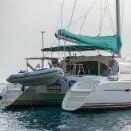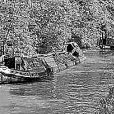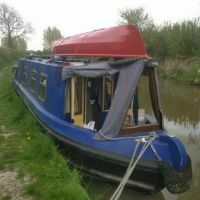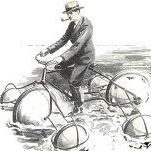All Activity
- Past hour
-
Paul H started following Width of bed in cabin
-
I don’t think a 3ft wide bed in a motor boat cabin is unusual in fact I’ve come across a 2ft 10” one. They were rarely occupied by two adults who would have chosen the more commodious butty with a 3ft 6in to sleep on. Of course the other limitation is the length between the lining boards on a wooden boat - 5ft 6ins if you’re lucky! in Tom Chaplin’s A Short History of the Narrow Boat there is a scan of a few pages of Frank Nurser’s notebook which gives the “bed place” as 2ft 9ins. Paul
-
Could be a small vole, or baby rat? Was it going clockwise or anticlockwise? If anticlockwise, its from Australia.
-
Welcome to the forum, indent for a fireproof suite of armour. If you want advice, here goes. First off, double check the prop, you could have something nasty on it. That would account for the vibration. Is there oil in the gearbox? Is it totally quiet out of gear? Is it the drive plate between the engine and the gearbox breaking up? There is no clutch there. TMC boxes usually whine even when new but not grind. Use a listening stick between your ear and various parts of the gearbox, engine, bell housing etc. to locate the source of the noise. Have you recently had something hard hit the prop? Could it be bent or the shaft bent or the engine mountings torn off? Is the engine running on all 4 cylinders? When and how did this start? Was anything altered just before?
-
Most probably damselflies -- we get lots of them around the pond here...
-
No sign of an otter but have been watching dragon flies (? The electric blue ones ) along side the canal. I met a dog walker along side the new bit in water ( but not navigable) watching what looked like a very small mouse swimming round on circles. We had no idea what it was - too small for a vole.
-
This post cannot be displayed because it is in a forum which requires at least 10 posts to view.
-
Q. How many legs does an otter have? A. Six.....Two at the back and Fore at the front. Otter lotta people know that.
-
There was an obstruction in the suction side pipework, and by swapping the pipes over it has been blown back out of the inlet.
-
They would have been soft paillasses, straw or flock, and capable of being bent to fit into the corners. So they were possibly oversize and one occupant had to sleep bent. Thankfully there were no bunk beds in BMCs!
-
Looking the other way 2022. I presume your photo was taken from the railway bridge. I'd noticed the differently-coloured patch of wall but had no idea there used to be a bridge there.
-
If not the Black Death it could be an Elton Elf boat.
-
This post cannot be displayed because it is in a forum which requires at least 10 posts to view.
-
Some years ago, when we lived in very rural Wales, the nearby village seemed to be a target for developers, there always seemed to be planning applications being submitted - these came to a halt when it turned out that there had been Otter footprints seen alongside the brook. An otter expert was called in and it turned out that the Otter appeared to have only one leg/foot, (the right fore leg). Further investigation led to a local who had carved an otter foot and was using it to make tracks wherever a planning application was being submitted. Unfortunately he only made the one-foot.
-
That is most strange, never had that happen. All I can think is that the vanes on the pump were lying the wrong way and now they are correct. Odd.
-
Sounds like you bedded the impeller blades in, but why that was needed I have no idea, and by the way, it won't be 10K revs, the BMC 1.5 (automotive) should be set to top out at about 4400 rpm. You probably mean 1000 rpm. If it was not anew pump, I would have suggested that the end plate and wear plate, either side of the impeller, were badly worn.
-

A million questions narrowed down to a few, for now :)
Alan de Enfield replied to Boater floater's topic in New to Boating?
Ah ............... you are thinking of the NBTA members that 'coagulate in great gatherings', remove their engines so they don't need to move and despoil the towpath and surrounding countryside. -
This post cannot be displayed because it is in a forum which requires at least 10 posts to view.
-
Waited near one of the bridges on the Monty a few years ago as there were fresh otter tracks in the mud there, but didn't manage to see one. Perhaps you might be luckier.
-
Betty (sic) Noir isn't the Prince of Darkness, that's Ozzy Osbourne ...
-
Heartland started following Newry Canal - first cross watershed - which was second?
-

Newry Canal - first cross watershed - which was second?
Heartland replied to magpie patrick's topic in History & Heritage
Putting aside China, the rest of Europe and the canals on Mars The Birmingham Canal as completed from Goldshill to Birmingham climbed up through 6 locks up and 6 locks down in November 1769 For the Trent and Mersey the progress to the tunnel mouth at Harecastle was still in progress and then they would have to descend from Kidsgrove to fit the condition of crossing the watershed. -
Greenpen started following Width of bed in cabin
-
I am trying to determine the width of the athwart bed in a working boat cabin. I am trying to draw the outlines of the contents of the cabin on the floor of Tooley’s Historic Boatyard Museum and it’s not proving straightforward! The dark blue represents the boatman’s cabin of NB Hardy. The masking tape shows the positions of (left to right) the steps down, range and bed. The wood object is the drop down table top. The bed is currently 3 feet wide. Two people in a 3 foot bed is cozy and I have been told it would have been wider. However, firstly I cannot fit it in and, secondly, I have a plan from Yarwoods for a tradition boatman’s cabin that shows it as 3 feet wide. I guess it may have varied but I would welcome any comments on its width. (Or of course, anything else!)
-
Strange thing reversed pipes on pump run at 10k revs for couple of mins placed pipes back correct way run upto 10k revs and it's working properly again😃 Thanks for all your help with this problem guys
-
I have a vetus m4.15 with a technodrive tmc 40 p gearbox makes a loud grinding sound and heavy vibration when engaged how can I tell if it's the clutch or gearbox prop shaft still seams to be OK and in line















